


You’ve probably seen thermal printer paper on receipts, shipping labels, or parking tickets. But what exactly is it? This guide breaks down what thermal paper is, how it works, the types available, and how to pick the right one.
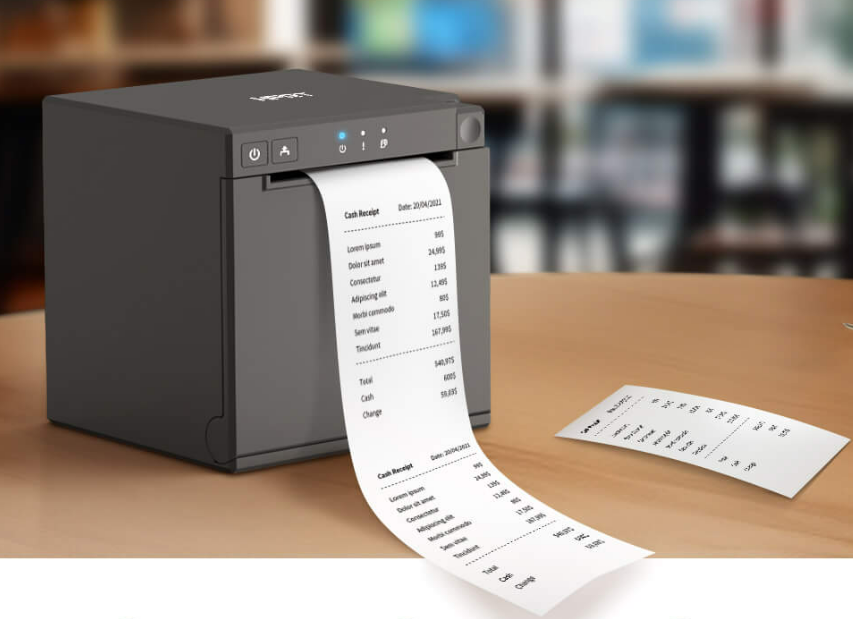
Thermal printing paper is a special type of paper coated with heat-sensitive layers that enable ink-free printing. It’s widely used in thermal receipt printers and portable A4 printers to generate receipts, tickets, invoices, and order slips quickly and cleanly.
Structurally, thermal printer paper consists of a base paper and two key coatings on the printing side: a precoat layer and a thermal layer. The base paper provides structural support and is specially engineered for thermal printing. The precoat layer improves heat insulation, smoothness, and helps anchor the thermal coating. The thermal layer contains reactive chemicals—such as dye, developer, and sensitizer—that turn black when exposed to heat, producing text or images without any ink.
Thermal paper works through a heat-activated chemical process. When heat is applied—typically by a thermal printhead—the coated layer reacts and darkens in the heated areas, forming legible text or images—no ink or toner required.

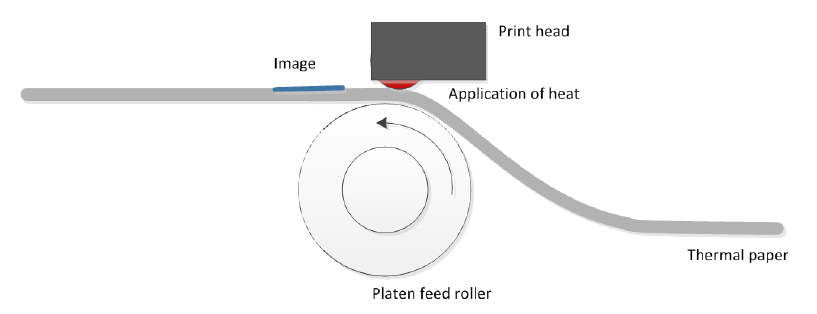
Can I use regular paper in a thermal printer?
Many people wonder about this—but the short answer is no. Thermal printers only work with heat-sensitive thermal paper, while regular paper is typically used in inkjet or laser printers. To understand why, here’s how thermal paper differs from regular paper in key aspects like printing method, durability, and cost.
| Feature | Thermal Paper | Regular Paper |
|---|---|---|
| Printing Method | Heat-sensitive coating | Requires ink or toner |
| Speed & Noise | Fast and quiet | Slower, can be noisy |
| Durability | Sensitive to heat/light, may fade | Longer-lasting (depends on ink) |
| Cost Efficiency | No ink needed, low maintenance | Higher cost due to ink and cartridges |
| Environmental Impact | Some types contain BPA/BPS | Recyclability depends on ink/toner used |
Paper for thermal printer is fast, quiet, and budget-friendly—but it can fade and doesn’t love heat. Regular paper is more durable, but needs ink and more upkeep. So which is better? It really depends on your needs. Since thermal printer paper is now used almost everywhere, let’s take a closer look at its main types and how to choose the right one.
Thermal printer paper comes in a various sizes and is available in both roll and sheet formats. The most common type is the thermal paper roll, used in receipt printers. In addition, A4 thermal paper, whether in roll or sheet form, is popular for mobile and office printing.
Choosing the correct one is key to smooth, jam-free printing. Use the wrong size, and you risk poor print alignment or even damaging your machine.
Here’s a quick guide to the most common thermal paper sizes:
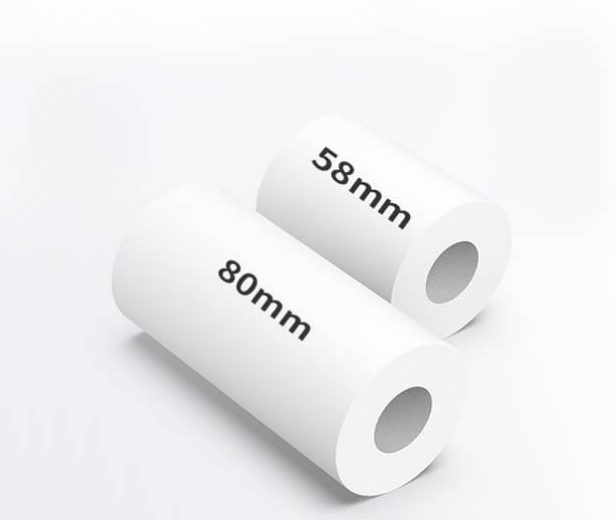
58mm Thermal Receipt Paper Roll–such as 58×30mm, 58×40mm, and 58×50mm, work with mobile receipt printers like the HPRT HM-E200 or compact desktop models. Perfect for handheld or countertop use in mobile POS setups.
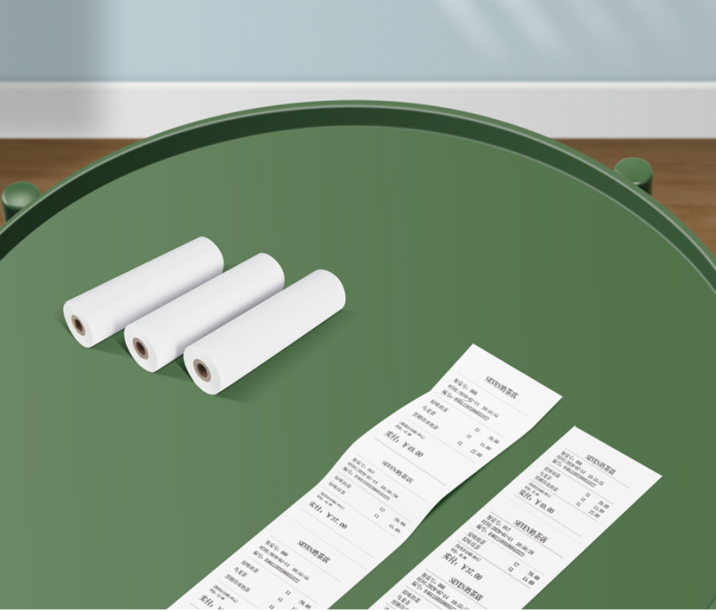
80mm Thermal Receipt Paper Roll – such as 80×60mm, 80×70mm, and 80×80mm, The go-to size for standard POS printers. Ideal for supermarkets, retail stores, and fast-paced checkout counters.
Looking for thermal printer recommendations? Check out our best receipt printers for small businesses in 2025.
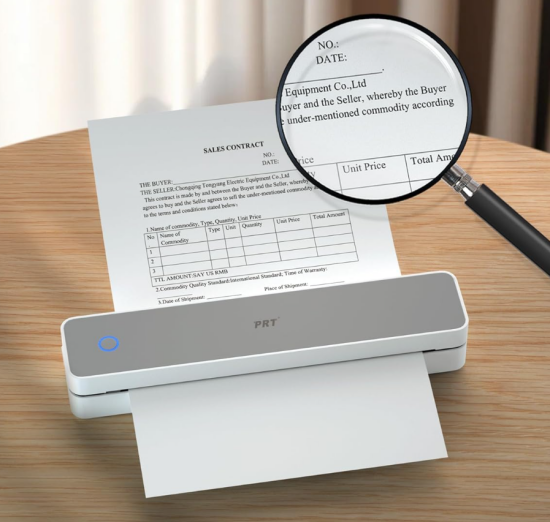
A4 Thermal Paper (210×297mm) – Specifically made for portable A4 thermal printers like the HPRT MT800. Great for printing contracts, forms, or reports on the go—no ink needed.
Pro tip: Matching your paper size to your printer model doesn’t just prevent problems—it also ensures every print looks sharp, aligned, and professional.
By looking at how thermal paper is used across industries, you can better understand which type and size suit your needs.
Common Sizes: 80×80mm, 58×50mm
Features: Clean print, anti-static, smooth feeding
Best For: Supermarkets, convenience stores, pharmacies
Common Sizes: 80mm
Features: Water, oil, and heat-resistant
Best For: Restaurant kitchens, cafés, food delivery stations
Formats: Gap, black mark, continuous
Features: Strong adhesive, scratch-resistant, no ribbon needed
Best For: Shipping labels, barcodes, inventory tags,transaction records
Features: High-definition, tamper-resistant, long-lasting(up to 10 years)
Best For: test reports, laboratory reagent labels, ATM receipts.
Size:: A4 (210×297mm)
Features: Ink-free, portable, easy for documents and sketches
Best For: Remote work, student printing, mobile contracts
| Application Scenario | Paper Type / Feature | Best For |
|---|---|---|
| Retail & POS | Thermal Receipt Paper (80×80mm, 58×50mm) | Supermarkets, pharmacies, convenience stores |
| Food Service | Kitchen Thermal Paper (80mm, water/oil/heat-resistant) | Restaurant kitchens, cafés, food delivery |
| Logistics & Warehousing | Thermal Label/receipt Paper (gap/black mark/continuous) | Shipping labels, barcodes, inventory tags |
| Banking & Healthcare | Premium Thermal Paper (long-lasting, BPA-free) | Lab results, ATM slips, tax invoices |
| Home & Mobile Office | A4 Thermal Paper (210×297mm, portable use) | Mobile contracts, student printing, home use |
Here are some of the most common types of thermal printer paper to help you quickly recognize the differences and avoid costly mistakes when choosing. Each type is designed for specific applications, so selecting the right paper—and matching it with the right printer—can make all the difference in print quality, efficiency, and overall performance.
Standard thermal paper is ideal for short-term use like receipts, queue tickets, and order slips. It’s affordable, reliable, and widely used in retail stores, restaurants, parking systems, self-service kiosks, and ticketing machines—anywhere fast, disposable printing is needed.
Just note: it may fade with heat or light over time.
Top-Coated or “Triple-Proof” Thermal Paper features a protective coating that resists water, oil, and scratches—making it ideal for demanding environments like restaurant kitchens, logistics centers, or outdoor settings.
For example, in restaurant back-of-house operations, the HPRT KP806 PLUS kitchen printer uses top-coated paper to print clearer, more durable prep orders that withstand heat, moisture, and grease.
Two-Color Thermal Paper: Prints in black plus red or blue, helping important text stand out. It’s perfect for receipts that need extra visual cues—like promotions, safety warnings, or brand highlights. Think pharmacy instructions, discount offers, or return policy notes.
For businesses that need this functionality, the customized version of HPRT TP807 receipt printer is a great fit—it supports custom two-color thermal printing, making important messages pop without slowing down your workflow.
BPA-free thermal paper offers the same clear, fast printing as standard thermal paper—without the health risks linked to bisphenol A. It’s a smart choice for businesses that value safety and sustainability.
Eco-friendly thermal receipt printers like the HPRT TP806 support BPA-free paper, delivering sharp and reliable results while aligning with environmental standards. They're perfect for POS systems, retail stores, and healthcare environments.
| Functional Type | Paper Type / Feature | Best For |
|---|---|---|
| Standard Thermal Paper | Standard - For short-term receipts/tickets | General POS, short-term use, budget printing |
| Top-Coated Thermal Paper | Triple-Proof – Water/oil/scratch-resistant | Kitchens, logistics, outdoor printing |
| Two-Color Thermal Paper | Two-Color - Black + red/blue for emphasis | Pharmacy labels, promotions, warnings |
| BPA-free thermal paper | eco-friendly thermal paper | POS, retail, and healthcare use |
Keep in a cool, dry place away from sunlight to prevent fading.
Use high-resolution settings and avoid low-grade paper to ensure scannability.
Always match your roll size and paper type to your printer’s specs.
Choose BPA-free options when available for safer, more sustainable use.
Sharp, dark prints that don’t smudge.
Sized and designed for your printer.
Fade resistance and water/oil protection.
BPA/BPS-free for health-conscious environments.
Well-wrapped to protect against humidity and dust.
Printers like the HPRT TP806/TP807 support eco-friendly thermal receipt paper—perfect if you want to reduce waste without sacrificing quality.
Thermal paper is everywhere—on store counters, in warehouse shipments, and inside mobile printers on the go. It may be small, but it packs a punch when it comes to keeping your operations running smoothly. Want fewer printing issues, lower costs, and better results? It all starts with choosing the right thermal paper—and HPRT is here to help you make the right choice.
Yes, but it's best to use BPA-free thermal paper, especially for receipts that are handled frequently in retail, food service, or healthcare. BPA-free options are safer for both users and the environment.
It depends on the type. Standard thermal paper lasts about 1–3 years, while some premium or top-coated paper can retain images for up to 10 years—as long as it's stored properly (cool, dry, and away from sunlight).
Thermal paper can be recyclable, but it depends on the coating.
BPA-free versions are more eco-friendly and are accepted by certain recycling programs. Always check local recycling rules.
For short-term or internal documentation, yes. However, for official long-term storage, traditional printed documents using pigment ink on archival-quality paper may be more reliable.
Nothing will print. Thermal printers need heat-sensitive paper to create images. Regular paper lacks the thermal coating, so even if it feeds correctly, it won’t produce any print.
Absolutely. Thermal printing eliminates the need for ink, toner, or ribbons, making it more cost-effective over time—especially for high-volume receipt or label printing.
Yes, but with a caveat. Because thermal prints can fade, it's a good idea to photocopy important thermal documents (like receipts or invoices) soon after printing to ensure a longer-lasting backup.